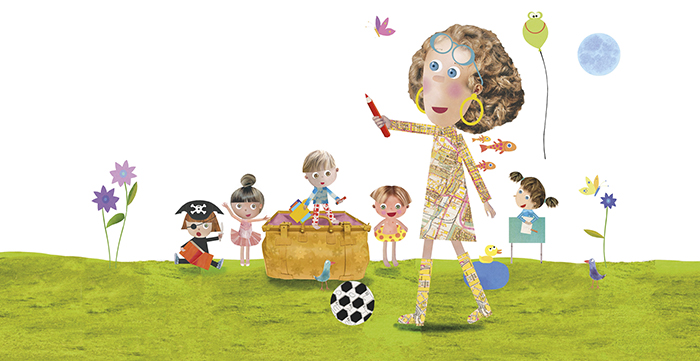 EN
EN
 PT
PT
Card games for learning Italian by having fun
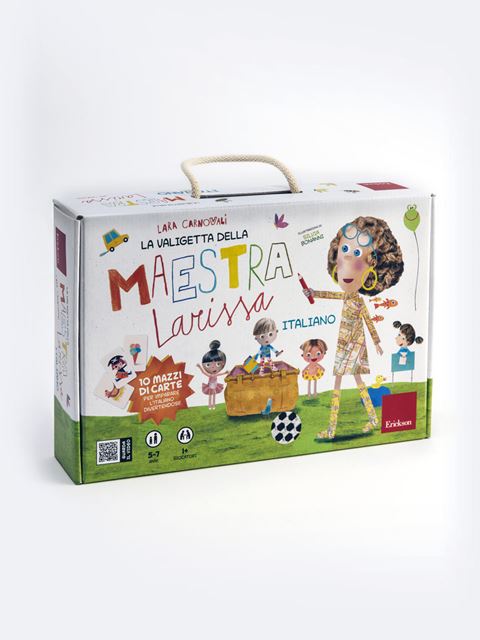
Product: Teaching tools
ISBN: 9788859011781
Suitable for: Nursery 2nd Level (ages 4-5), Primary 1st level (ages 6-7)
REQUEST A SAMPLE OR MORE INFORMATION
Every teacher in Italy knows the primary school teacher called Larissa; her blog and her Facebook page have become a reference point and goldmine of material for colleagues in search of new exercises and activities to give their pupils (and also for parents who are looking for effective, engaging material for at home study and revision).
From her experience comes this new tool: a colour-illustrated cardboard briefcase containing 10 packs of practical colour cards, some with pictures and others with words/syllables or letters.
The cards are designed to be used by primary years one and two pupils for learning the reading and writing process, and allow children to play and learn independently, helping teachers offer different, fun, stimulating activities.
Used in progression, the packs of cards encourage a gradual yet at the same time exacting approach to the world of reading and writing.
More than 20 activities can be carried out!
The briefcase contains:
- 10 packs of colour cards
- 2 colour tables
- 6 counters
- 1 die
- introductory guide and instructions
The following games can be played:
- RHYME, REMAIN! (identifying words that rhyme with each other)
- INITIAL CONSONANTS (hearing and recognising consonants)
- A DAY WITH LUCIA AND FABRIZIO (reading and understanding simple phrases correctly)
- MATCH THE PHRASE (reading and understanding simple phrases)
- SEQUENCES (recognising the parts of a story and putting them in the right order)
- SPELLING MEMORY (recognising and learning how to read the main spelling difficulties in the Italian language)
- OOPS! (understanding texts and matching them with the correct pictures; boosting memory)
- UPPER AND LOWER CASE (matching capital letters and small letters)
- THE DOUBLES GAME (recognising double consonants and pronouncing them correctly)
- FORGET THAT SOUND (reading and recognising digraphs in the Italian language)
- INITIAL SYLLABLES (recognising phonology: matching sounds to syllables)

We are used to thinking of games as pastimes, which are unstructured, free and self-guided. But does separating learning, work and play really make sense for teachers?
It has been demonstrated that when learning has a positive emotional impact on students, they are more likely to consolidate it.
The 11 games and the 20 activities and more that can be done with the 550 Teacher Larissa cards satisfy several teaching objectives set out for the first few years of primary school:
The different activities presented offer a fun and stimulating approach to the world of reading and writing, covering some of the main teaching objectives in language for primary years one and two.
The variety of packs and activities offered allow the teacher to set up several play groups at the same time; an opportunity not to be underestimated if you want to make your teaching stand out. Furthermore, children can play the individual games by themselves thanks to the self-correcting system.
ALL THE GAMES IN THE BRIEFCASE
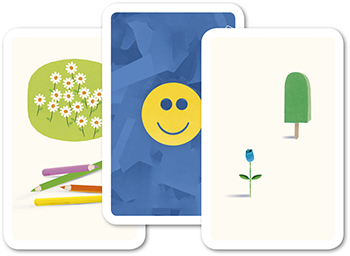
RHYME, REMAIN!
• Recognising and producing rhymes
• Developing lexical competences
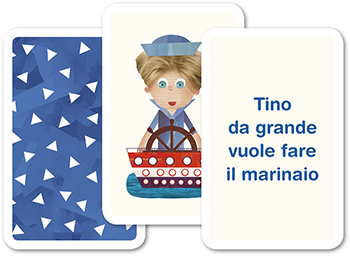
GUESS WHO?
• Reading and understanding simple phrases
• Matching each phrase to its corresponding picture
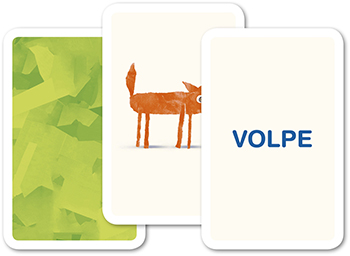
OOPS!
• Reading and understanding short words
• Visually discriminating pictures
• Building and developing mnemonic skills
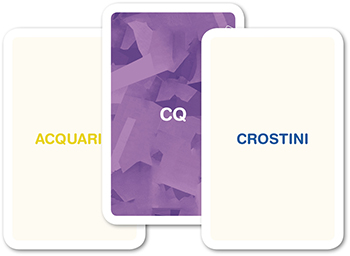
FORGET THAT SOUND
• Reading and understanding words with difficult spelling
• Reading and writing the main consonant groups in the Italian language
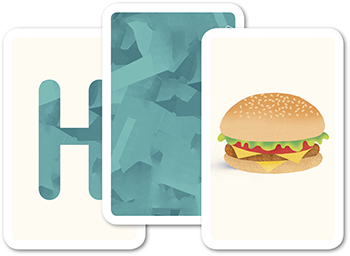
INITIAL CONSONANTS
• Understanding and recognising consonants
• Matching graphemes with phonemes
• Developing lexical competences
• Recognising the main lexical categories in the Italian language
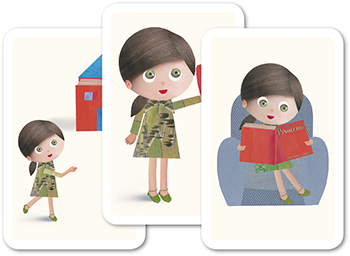
BEFORE AND AFTER
• Recognising the chronological organisation of a story and putting it in the right order
• Understanding and recognising the narrative structure of a text
• Identifying cause and effect logical relationships
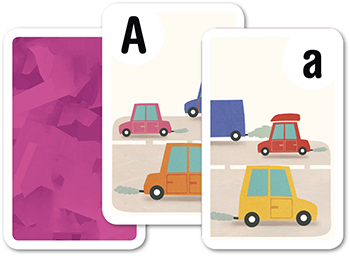
UPPER AND LOWER CASE
• Recognising graphemes (printed upper and lower case)
• Building and developing mnemonic skills
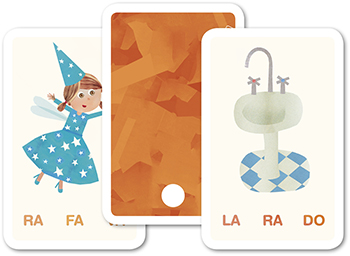
INITIAL SYLLABLES
• Matching sounds to syllables
• Relating words and pictures
• Identifying the first syllable of a word
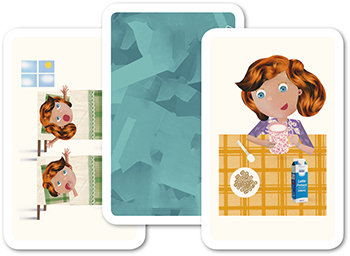
LUCIA AND FABRIZIO
• Reading and understanding simple phrases
• Matching the written phrases to the right illustration
• Developing mnemonic skills
• Producing articulate phrases
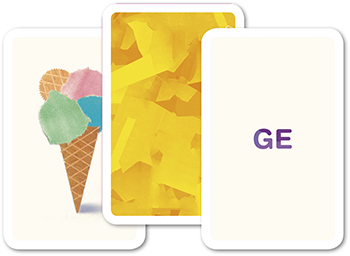
SPELLING MEMORY
• Recognising the main spelling difficulties contained in the words
• Using words with difficult spelling
• Training and developing mnemonic skills
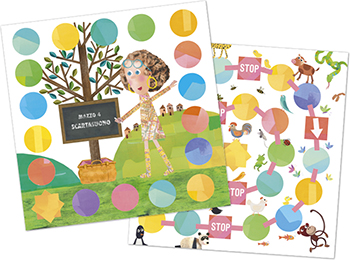
THE DOUBLES GAME
• Recognising words that contain doubles
•Correctly pronouncing the double sound of consonants
• Developing mnemonic and attention skills
All these decks of cards are designed to be used by children on their own or in groups in order to consolidate, review and revise knowledge acquired and, in some cases, to improve a child's performance in certain tasks.
Different games are presented with a varying number of players in order to ensure scope and diversity which renders each deck unique. At the same time some of the decks can be used in several different ways, increasing the number of potential games.
HOW TO USE THE DECKS?
Teachers presenting the card games to the class can organise the activities in many different ways. For example they can:
• set aside an hour a week for «didactic games», where the children can freely choose what games to play, can split up into groups and play by themselves. Here the cards are used more as a revision and consolidation tool than a learning tool.
• Put the card games in the classroom alongside other activities with the same objective, which children can choose independently.
• Use the briefcase of cards as a «filler», to engage children who have finished other didactic activities before their classmates in playful revision. Some games have been specifically designed for this reason, like self-correcting patience games that each child can use independently.
• Present the games in unstructured free periods, like break or lunchtime, leaving it up to the kids to decide whether to play or not. Self-correcting is an essential element in the games involving just one person; as you are not always able to assess whether you have done it correctly, it lies with the material itself to give the player confirmation. In this respect the games presented follow a well-established principle led by Montessori, who, in designing his material, held the fact that an adult or third person was not necessary because the child could understand if they had done it correctly or not in high regard.
IN CLASS, AT HOME, ON A TRIP…SO MANY POSSIBILITIES FOR PLAYING AND HAVING FUN TOGETHER!
The decks of cards contained in the briefcase are not only to be used as teaching tools for the classroom. Above of all they are games and as such can just as well be used at home for consolidation of learning or simply for pleasure and fun.
The central idea which we are trying to encourage is that school learning and knowledge should not be confined to the walls of the classroom and that learning is pleasurable, fun, and a positive shareable experience which has no boundaries. Children can play in their rooms, after dinner with the whole family or they can put the cards in their rucksack and play with them when they are on a trip.
Ultimately, it is a question of taking back the pleasure of playing and starting to experience learning as pleasant, fun and engaging.
